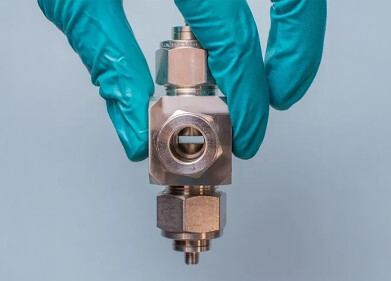Analytical Instrumentation
New high frequency reciprocating rig
Jan 17 2020
Koehler Instrument Company, Inc recently introduced their newly redesigned High Frequency Reciprocating Rig. This instrument can be used for the evaluation of the lubricity of diesel fuels utilising a high frequency reciprocating rig (HFRR). A 2-mL test specimen of fuel is placed in the test reservoir and maintained at 25 or 60°C. At the point of temperature stabilisation, a vibrating arm, wielding a non-rotating steel ball and loaded with a 200-g mass, subsequently descends until it makes contact with a test disk entirely submerged in the fuel. A 1-mm stroke, at a frequency of 50 Hz for 75 minutes, is the catalyst which causes the ball to rub against the disk. The ball is then removed from the vibrating arm and cleansed. The dimensions of the major and minor axes of the wear scar are measured under magnification and recorded.
The specifications include the following: it conforms to ASTM D6079, D7688; ISO 12156; IP 450; EN 590; CEC F-06-S. The HFRR has a variable frequency ranging from 10 Hz to 200 Hz via software (K9346X Model). Wear scar measurement occurs through a digital microscope and software. The instrument features real time data acquisition of frictional force, temperature and humidity (K9346X Model). Programmed test sequences to facilitate automated examination are included. PC-based digital and data acquisition is featured as well (K9346X Model). In addition, the user can rely on proven repeatability and reproducibility of empirical data from the sturdily built and dependable table top rig.
The versatility of the high frequency reciprocating rig is found in a computerized piece of equipment adept at accurate detection of frictional behavior and the wear properties of materials under both dry and lubricated conditions. Reciprocation motion takes place employing the fixed stationary counter surface materials, mounted on a small lubricant bath, and the reciprocating specimen (ball) frequency, displacement and normal load, chosen based on individual test requirements.
Digital Edition
PIN 25.5 Oct/Nov 2024
November 2024
Analytical Instrumentation - Picturing Viscosity – How Can a Viscometer or a Rheometer Benefit You? - Sustainable Grease Formulations: Evaluating Key Performance Parameters and Testing Method...
View all digital editions
Events
Dec 03 2024 Dusseldorf, Germany
Dec 08 2024 Anaheim, CA, USA
Turkey & Black Sea Oil and Gas
Dec 11 2024 Istanbul, Turkey
Dec 19 2024 Aurangabad, India
Jan 20 2025 San Diego, CA, USA



















